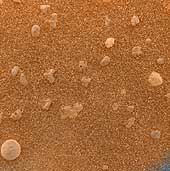|
COMETS EARTH JUPITER KUIPER BELT MARS MERCURY METEORITES NEPTUNE OORT CLOUD PLUTO SATURN SOLAR SYSTEM SPACE SUN URANUS VENUS ORDER PRINTS
PHOTO CATEGORIES SCIENCEVIEWS AMERICAN INDIAN AMPHIBIANS BIRDS BUGS FINE ART FOSSILS THE ISLANDS HISTORICAL PHOTOS MAMMALS OTHER PARKS PLANTS RELIGIOUS REPTILES SCIENCEVIEWS PRINTS
|
Related Documents
Download Options
This magnified look at the martian soil near the Mars Exploration Rover Opportunity's landing site, Meridiani Planum, shows coarse grains sprinkled over a fine layer of sand. The image was captured by the rover's microscopic imager on the 10th day, or sol, of its mission and roughly approximates the color a human eye would see. Scientists are intrigued by the spherical rocks, which can be formed by a variety of geologic processes, including cooling of molten lava droplets and accretion of concentric layers of material around a particle or "seed". The examined patch of soil is 3 centimeters (1.2 inches) across. The circular grain in the lower left corner is approximately 3 millimeters (.12 inches) across, or about the size of a sunflower seed. This color composite was obtained by merging images acquired with the orange-tinted dust cover in both its open and closed positions. The blue tint at the lower right corner is a tag used by scientists to indicate that the dust cover is closed. |
